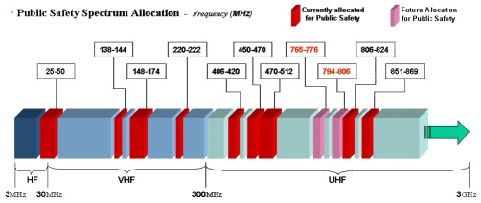By the National Institute of Justice
Key points:
– Radio communications use radio waves at different frequencies.
– The range of frequencies used for communication is called spectrum.
– The FCC regulates use of spectrum.
– Spectrum is an increasingly scarce resource, and public safety competes with commercial interests for this resource.
– Spectrum in the 700 MHz band has been allocated (but is not yet available) to public safety to help meet increasing demand.
The basic building block of radio communications is the radio wave. Like waves on the ocean, a radio wave is merely a stream of repeating peaks and valleys. The entire pattern of the wave, before it begins to repeat itself, is called a cycle. These cycles repeat over time. The number of cycles, or times that the wave repeats, each second, is called frequency. The term Hertz, often abbreviated Hz, is the unit of measurement used for frequency, and refers to the number of cycles per second. One thousand Hertz is referred to as Kilohertz, or kHz; one million Hertz as Megahertz, or MHz; and one billion Hertz as Gigahertz (GHz).
The complete range of frequencies that could be used for radio communications is called the spectrum. Radio spectrum ranges from approximately 30 kHz to up to more than 300 GHz. Frequencies are often grouped in ranges called bands. Bands of interest to public safety include HF (high frequency), VHF (very high frequency), and UHF (ultra high frequency). A radio wave is generated by a transmitter, and received by a receiver. An antenna allows a radio transmitter to send energy into space and a receiver to pick up energy from space. Transmitters and receivers typically operate over a range of frequencies in a specific frequency band.
The Federal Communications Commission (FCC) regulates use of any specific frequencies. The FCC has allocated certain portions of the spectrum for use by public safety agencies. These portions are divided up as the illustrated diagram that follows demonstrates. Radio systems using spectrum in the 800-824 MHz and 851-869 MHz portion of the UHF band are often referred to as “800 MHz systems” and distinguished from systems in the other parts of the UHF band.
The FCC issues licenses for groupings of frequencies into categories called channels. When the FCC licenses a channel, it specifically identifies the center frequency (or carrier frequency) for that channel. This central frequency is the main frequency for carrying the information to be transmitted. Thus, the radio information is transmitted over the range of frequencies contained within a single channel.
Spectrum is an increasingly scarce resource. Public safety allocations for state and local public safety are fragmented into many different slices of radio spectrum, as shown in the diagram that follows. Because only a portion of the spectrum in the highlighted blocks is available, the total amount of state and local public safety allocated within these groups is 47.2 MHz.

To avoid having one radio system receive transmissions from a different radio system because both systems use the same frequency, the FCC ensures that a channel is licensed to only one user in a given area. In fact, prior to applying to the FCC for a license, an agency must first obtain specific frequencies of operation from a frequency coordinator. The coordinator will check to see what frequencies are available in that area and assist in evaluating options.
Increasing demand for wireless communications capabilities among all users, including public safety, led the FCC to reallocate frequencies currently being used by some television stations for broadcast. Frequencies covering TV channels 60-69 have been reallocated to private use and public safety, but will not be available for public safety use until the TV channels give them up. Public safety’s portion, 24 MHz, will include frequencies from 764 to 776 MHz and from 794 to 806 MHz. An implementation schedule is still being developed, and manufacturers are gearing up to produce equipment to work in this frequency band. The first public safety use of this portion of spectrum is not likely to be available until 2006 in most areas.
For more information:
AGILE: Interoperability Strategies for Public Safety Website: www.agileprogram.org.
Interoperability Resource CD-ROM, request via email at askagile@ojp.usdoj.gov, or call 1-202-514-5687.
Or contact a regional National Law Enforcement and Corrections Technology Center:
Northeast (Rome, NY) 888-338-0584
Southeast (Charleston, SC) 800-292-4385
Rocky Mountain (Denver, CO) 800-416-8086
Western (El Segundo, CA) 888-548-1618











